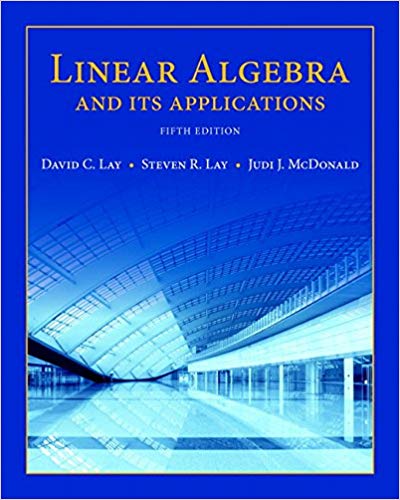
Linear Algebra and Its Applications, 5th Edition
Authors: David C. Lay, Steven R. Lay, Judi J. McDonald
ISBN-13: 978-0321982384
We have solutions for your book!
See our solution for Question 28E from Chapter 7.2 from Lay's Linear Algebra and Its Applications, 5th Edition.
Problem 28E
Chapter:
Problem:
Let A be an n × n invertible symmetric matrix. Show that if the quadratic form xTAx is positive definite, then so is the quadratic form xTA–1x. [Hint: Consider eigenvalues.]
Step-by-Step Solution
Given Information
We are given that $A$ is an $n \times n$ invertible symmetric matrix. We have to show that if the quadratic form $\mathbf { x } ^ { T } A \mathbf { x }$ is positive definite, then so is the quadratic form $\mathbf { x } ^ { T } A ^ { - 1 } \mathbf { x }$ .
Step-1:
For an invertible symmetric matrix, its inverse is also symmetric, hence $A^{-1}$ is also symmetric.
The eigenvalues of A are positive because the quadratic form $\mathbf { x } ^ { T } A ^ { - 1 } \mathbf { x }$ is positive definite. The eigenvalues of $A^{-1}$ are are reciprocal of the eigenvalues of A, hence they are also positive.
Since the eigenvalues of $A^{-1}$ are positive and it is a symmetric matrix, therefore,
Its quadratic form, $\mathbf { x } ^ { T } A ^ { - 1 } \mathbf { x }$ is positive definite.
We are given that $A$ is an $n \times n$ invertible symmetric matrix. We have to show that if the quadratic form $\mathbf { x } ^ { T } A \mathbf { x }$ is positive definite, then so is the quadratic form $\mathbf { x } ^ { T } A ^ { - 1 } \mathbf { x }$ .
Step-1:
For an invertible symmetric matrix, its inverse is also symmetric, hence $A^{-1}$ is also symmetric.
The eigenvalues of A are positive because the quadratic form $\mathbf { x } ^ { T } A ^ { - 1 } \mathbf { x }$ is positive definite. The eigenvalues of $A^{-1}$ are are reciprocal of the eigenvalues of A, hence they are also positive.
Since the eigenvalues of $A^{-1}$ are positive and it is a symmetric matrix, therefore,
Its quadratic form, $\mathbf { x } ^ { T } A ^ { - 1 } \mathbf { x }$ is positive definite.